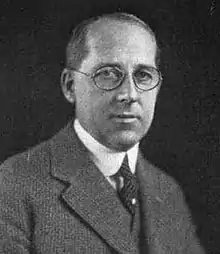William A. Starrett | |
|---|---|
 | |
| Born | William Aiken Starrett June 14, 1877 Lawrence, Kansas, U.S. |
| Died | March 25, 1932 (aged 54) Madison, New Jersey, U.S. |
| Alma mater | University of Michigan |
| Occupation | Builder |
| Known for |
|
| Notable work | Empire State Building |
William Aiken Starrett Jr. (June 14, 1877 – March 25, 1932) was an American builder and architect, best known for his work overseeing the construction of New York City's Empire State Building.
He was born on June 14, 1877, in Lawrence, Kansas. He left the University of Michigan in 1895 after two years and finally received a bachelor's degree in civil engineering two decades later. He married the former Eloise Gedney on June 14, 1900.[1]
In Skyscrapers and the Men Who Build Them, he described the construction of skyscrapers as "the nearest peacetime equivalent of war". On behalf of Starrett Brothers and Eken, the general contractor on the construction of the Empire State Building, Starrett oversaw the demolition of the Waldorf-Astoria Hotel and the completion of the Empire State Building on May 1, 1931, a total of 410 days.[2]
He died on March 25, 1932, at his home in Madison, New Jersey, as the result of a stroke. A Republican, he had served as the borough's mayor.[1]
References
- 1 2 "Col. W. A. Starrett, Noted Builder, Dead. Was Coordinating Official of Extensive Realty, Finance and Construction Enterprises.", The New York Times, March 27, 1932. Accessed March 25, 2023.
- ↑ Christianson, Scott. "When the Empire State Building Was Just an Architect’s Sketch", Smithsonian Magazine, November 10, 2015. Accessed March 25, 2023. "The general contractor was Starrett Brothers & Eken, the recognized leader in skyscraper construction. Indeed, one of the brothers, William A. Starrett, had recently authored the book, Skyscrapers and the Men Who Build Them, in which he wrote: 'Building skyscrapers is the nearest peacetime equivalent of war... The analogy of war is the strife against the elements.'"
Further reading
- Benardo, Leonard; Weiss, Jennifer (2006). Brooklyn By Name: How the Neighborhoods, Streets, Parks, Bridges, and More Got Their Names. New York University Press. pp. 131–132. ISBN 978-0-8147-9149-3.
- "Associated General Contractors: A.G.C. Biographies". Contractors' & Engineers' Monthly: 59–60. December 1921.
- Cody, Jeffrey W. (2003). Exporting American Architecture 1870–2000. Routledge. pp. 74–78. ISBN 9781135804879.
- Fenske, Gail (2008). The Skyscraper and the City: The Woolworth Building and the Making of Modern New York. University of Chicago Press. p. 169. ISBN 978-0-226-24141-8.
- "[Obituaries] Colonel William A. Starrett, 1877–1932". Architecture. 65 (4): 20. April 1932.
- "Who's Who in Construction". The Bulletin of the Associated General Contractors Association. 12 (4): 39. April 1921.
- "[uncertain]". The Gothamite. University of Michigan Club of New York: 15, maybe others. 1910.
- Langmead, Donald (2009). Icons of American Architecture: From the Alamo to the World Trade Center. Vol. 1 and 2. Greenwood. p. 90. ISBN 978-0-313-34207-3.
- Kingston, George C. (2017). William Van Alen, Fred T. Ley and the Chrysler Building. McFarland & Company. pp. 112, 125–127, 134, 146. ISBN 9781476668475.
- A Handbook of Economic Agencies of the War of 1917. Vol. 3. Historical Branch, War Plans Division, General Staff. 1919.
- Tauranac, John (2014). The Empire State Building: The Making of a Landmark. Cornell University Press. pp. 172–179. ISBN 978-0-8014-7109-4.
- United States War Dept (1919). War Expenditures: Hearings Before Subcommittee No. 2 (Camps) of the Select Committee on Expenditures in the War Department. Vol. Serial 3—Part 27. U.S. House of Representatives. pp. 2525–2538.
- Willis, Carol, ed. (1998). Building the Empire State. W.W. Norton. p. 12. ISBN 978-0-393-73030-2.